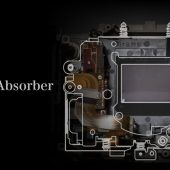Fujifilm went beyond just adding rigidity to the new Fujifilm X-H1. They also redesigned the cameras thermal footprint in their new article X-H1 Development Story #2 -Frame Pt.2.
“The continuous movie shooting time for X-H1 is 1.5x longer than X-T2. 4K shooting requires high processing power and to avoid the overheating issue, there is the limiter. So how can the X-H1 take longer movies than the X-T2 while the two cameras use the same device?
The frame design is one of the answers. The X-H1 has a larger heat sink to efficiently dissipate the heat generated by the processor to the outside. And by transferring the heat absorbed by the heat sink to the front and back of the camera and by securing more surface area, the heat is released to the outside of the camera in much quicker time.”
The article also touches on the new IBIS system, but future articles will go into more detail.
The IBIS unit is supported by endoskeletal framework. The framework has a complicated shape, so magnesium, which is excellent in workability, was adopted. The frame is considerably thick. So it itself is a solid support, but steel reinforcements are combined to further increase the strength. Even if the IBIS unit vibrates at a high speed, it will not move a tiny bit.”
Fujifilm has always designed its cameras to suppress shutter shock and they have a tried and tested focal plane shutter that causes very little vibration to begin with, but the implementation of IBIS introduced one more element that could move and blur a photo when the shutter moves so Fujifilm redesigned their shutter to be suspended by springs.
“The shutter unit is suspended with five springs so they act as a shock absorber when the shutter is pressed. With this, vibration is not transmitted to other devices inside the camera.
The tension of each of these five springs is different because the impact on each of the 5 points is different when the shutter is pressed. The effect of this countermeasure is astounding. The impact on the image quality is barely noticeable.
The shock absorber also contributes to quietness of the shutter. You can see the adavantage with the following videos by Robert Falconer and Fabio Lovino.”
This sounds like a very interesting approach for suppressing vibration, but I wonder if this will affect how long these cameras last. Springs tend to lose tension over time and need service. This isn’t a short-term issue to worry about, but in 3-5 years the springs might go out of speck or an extremely violent acceleration could cause them to become damaged. Not something you have to worry about if you upgrade frequently, but I know a few photographer that like to keep cameras a very long time.
I keep going back and forth about whether I want a Fujifilm X-H1 or not, but the more we learn about this camera the more I hope these features end up in the Fujifilm X-T3 later this year. Make sure you check out Robert Falconer’s video below he’s been a great help lately and is a reader of the site. Drop any questions you might have for him below and I am sure he will be more than happy to answer them.
Follow us on Facebook, Twitter, Instagram, YouTube
Fujifilm X-H1 News, Rumors, and Collaboration
Fujifilm X-H Owners Group
Fujifilm X-H Page
X-H1 Camera: B&H Photo / Amazon / Adorama
X-H1 Body with Battery Grip Kit: B&H Photo / Amazon / Adorama
VPB-XH1 Vertical Power Booster Grip: B&H Photo / Amazon / Adorama



